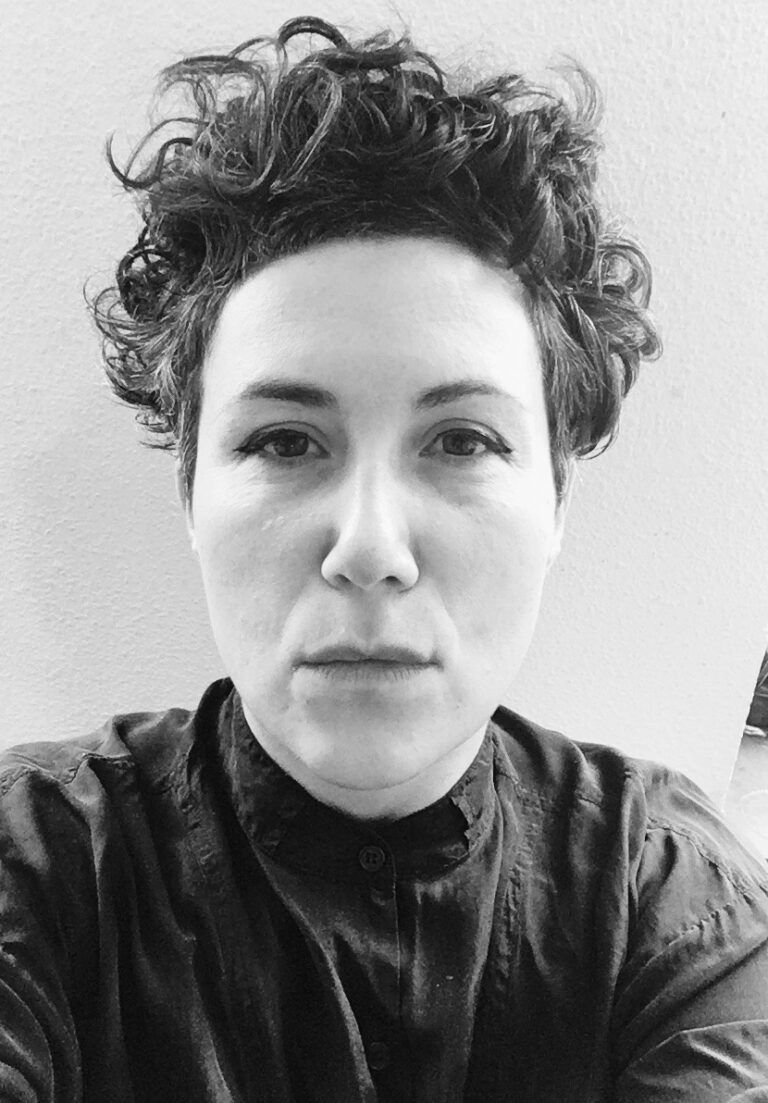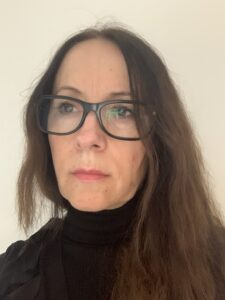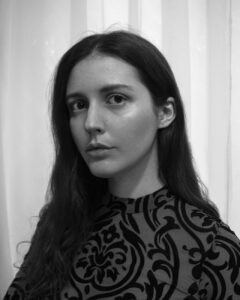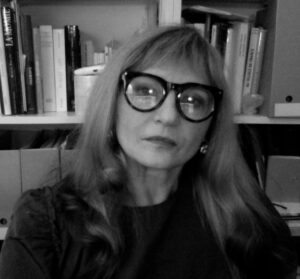Katarina Zdjelar

– born in 1979, Katarina Zdjelar grew up in Belgrade and is currently based in Rotterdam. Working mainly in the medium of video, her work explores the way one body encounters another as a site of resistance and possibility, pointing to the fragile agency of collective action in the present. Voice, music, sound and language have been the core interests throughout her practice. Her most recent works look at the potentials and legacies of pacifist (proto) feminist practices, including that of Käthe Kollwitz and Dore Hoyer. Zdjelar holds an MA in Fine Art from the Piet Zwart Institute in Rotterdam, she is a graduate of the University of Arts Belgrade and has completed a two year residency at the Rijksakademie van beeldende kunsten in Amsterdam. Zdjelar represented Serbia at the 53rd Venice Biennale.
Over the past years I have been interested in the investigation of the manifold ways in which to negotiate between the code of language and the physicality of speech, as well as an investigation into the ways in which language draws us together into communities1. Language learning is of particular significance for me as this is a codified method of cultural integration not only involving a symbolic “rite of passage” of the uprooted individual, but also the very material and corporeal effects shaping this “speaking body”. My interest in language emerged from practical applications of a “caring control” imposed by regulated systems of social adoption and inclusion in the developed, liberal societies of the world2. The dialectic of individual and community is of interest in my work. I articulate this in the rift between a universally valid, abstract language and a concrete, always physical voice.
Concerned with ideas of foreigners, estrangement and normalization, I explore processes of self-realization with all their paradoxes, promises and failures. I am particularly engaged with the inhabitation of regulated systems (knowledge, language, ideology) by non-authoritarian voices (amateurs, foreigners, children), who challenge the system in which they appear, in terms of ethics, value, and currency3. Working with a variety of subjects, from a phonetic transmutation by non-English speakers of the ‘Tears for Fears’ song, utterances in the Russian language by the citizens of Tirana, to ‘foreign accent removal’ treatment, my work over the past years has been looking at the relation between an individual and a collective (how an act of speaking marks an individual, what are the limits of expression). From the impact of assimilative language policies imposed on particular groups of people (observed in an asylum camp in Slovenia; integration school for foreigners in the Netherlands; a primary school in Turkey), to abstract manifestations of speech, including the musicality of speech and the physicality of the voice, and instances in which even the most intimate tilting, tinging, and tuning of one’s voice opens up the social relation between receiving a voice and having a voice, are all concerns in my work. It is a voice that lingers, which is in the process of arriving, on the threshold, that I am eager to observe and follow4.
I am articulating these ideas through the moving image and sound, two elements which I equally use in my video pieces. I broaden my interest in these ideas through various discursive projects which allow me to share and gain new knowledge, in a dynamic interaction with other practitioners from different fields. I create different platforms for knowledge building, speculation and exchange (including curating, writing, organizing symposiums and discussions, making book projects etc.).
It is often interruptions that speak in my work, as I am exploring narratives that cannot be told in/as a continuum. For instance, one of my most recent works, AAA (Mein Herz) is a single-shot work showing a young woman simultaneously performing four compositions5. While preserving the original style, tempo, and rhythm of the individual works, she maintains the key of the different music pieces. Silence, music, sound and words alternate and collide. The female protagonist’s face and vocal chords serve as a battleground for the jerky transition between the different tracks. As if the sounds have been continuously torn from their sockets putting an emphasis on the multiple, fragmented yet simultaneous temporalities which run the economy of her voice and the composition. It is the interruptions that speak, the corporeality of the voice. Her singing is as much about managing the gaps between the tracks as it is about the accuracy of performance of each of these historically, stylistically and linguistically distinct compositions.
One of my latest works “Not a Pillar not a Pile (Dance for Dore Hoyer)” is inspired by archival documents from an all women’s dance studio founded in 1945 in post-war Dresden by Dore Hoyer, a choreographer and expressionist dancer, whose choreographies took the graphic works of artist Käthe Kollwitz as their departure point. My latest film installation departs from this artistic meeting between Kollwitz and Hoyer as a manifestation of shared affinities with (proto) feminist pacifism, solidarity and collective transformation across the barriers of time, class and social difference. Drawing the past into the present, I have gathered an international group of dancers and activists to create this filmic work. Their costumes and the film set bear a pattern created by women workers of the Pausa textile factory in Germany, whose anti-fascist resistance resonates with that of Hoyer and of Kollwitz, and the latter’s graphic works are in turn echoed in the wood cut floor panels. In the resulting film installation one body encounters another as a site of resistance and possibility, pointing to the fragile agency of female collective action in the present678.
I mainly employ the rehearsal as a working method to explore the voice as a subject and substance. For the video “Reading ‘Europe, Where Have You Misplaced Love?’” I brought together four musicians for an improvisational interpretation of a poem written by Athena Farrokhzad, Europe, Where Have You Misplaced Love?. The aim of the improvisation is not so much to arrive at a final performance, but rather to keep the range of possibilities open. One by one the musicians take control and then let it go again just before arriving at a common melody, at which point doubts or another voice steer the process in a different direction. It becomes a continuous search in which a multiplicity of interrelating voices coexists. This approach adds a layered interpretation to Farrokhzad’s reflections: https://lithub.com/athena-farrokhzad-europe-where- have-you-misplaced-love/ (accessed 01.02.2019)91011.
Text is written in collaboration with Jelena Vesić (2022)
1Image: Katarina Zdjelar, Shoum, video still, 2008, courtesy of the artists. Video work Shoum starts with a blank screen and the sound of the 1984 Tears for Fears megahit Shout. Then we see an iPod, a sheet of paper and the hands of two men from Belgrade, holding pens. Over the course of the next seven minutes we observe how the two attempt to decipher the lyrics of Shout as though they contain a coded message. They speak no English. They phonetically transcribe what they hear, based on their own vocabulary and capacity to vocally interpret the unfamiliar. "Shoum Shoum Lajdi o Lau", they write and sing, in a strange invented language somewhere between phonetic transcription, Serbian, and English, as Tears for Fears sing "Shout, shout, let it all out".. Cut off from the lingua franca of a globalized world, these two men create something on their own that lies between the foreign and the familiar. We witness how through errors and deformations an entirely "new language" is being created.2Image: Katarina Zdjelar, The Perfect Sound, video still, 2009, courtesy of the artists. We see a grey-haired man chanting monosyllables, over and over, and a young man mimicking him simultaneously. What we see is an accent removal class for an immigrant conducted by a speech therapist in Birmingham (UK), a city which is paradoxically known for its strong accent. The British context is particularly stratified since in the UK language and speech reveal not only one’s status as a foreigner, but also the last remaining, almost impenetrable traces of the class system.
3Image: Katarina Zdjelar, Rise Again, video still, 2010, courtesy of the artists. Rise Again focuses on a number of men who are asylum seekers from Afghanistan. Discovering and inhabiting the wood proximate to the asylum center in which they live, they step outside of their prescribed roles as refugees and engage in voluntary social activities within this oasis, surrounded by highways at the edge of town. By combining allegorical imagery with martial arts elements, played and documentary scenes, the video develops a narrative structure in which these men appear in an unfolding transformation.
4Image: Katarina Zdjelar, Stimme, video still, 2013, courtesy of the artists. The video piece Stimme focuses on the training between a voice coach and her client, a young woman who fails to speak with her own voice. Focusing on the instances of having and receiving voice and its pitch, the piece opens up questions around the political and historical implications of voice modulation and its pitch, its economy and the politics of anatomy. The piece considers the questions of when voice becomes our personal property, where does the voice begin, who is speaking when we speak and who is entitled to speak? The body of a trainee is akin to a musical instrument.
5Image: Katarina Zdjelar, AAA (Mein Herz), video still, 2013, courtesy of the artists. Recorded entirely in 1 take, 4 different compositions (simultaneously yet interchangeably) are performed as one by vocalist Barbara Kinga Majewska. With the intention of keeping the original style, tempo and rhythm of the individual compositions intact, the performer takes a vocal walk through them.
6Image: Katarina Zdjelar, Not A Pillar Not A Pile (Dance for Dore Hoyer), still image from the multi-channel video installation, courtesy of the artists.
7Image: Katarina Zdjelar, Not A Pillar Not A Pile (Dance for Dore Hoyer), still image from the multi-channel video installation, courtesy of the artists.
8Image: Katarina Zdjelar, Not A Pillar Not A Pile (Dance for Dore Hoyer), still image from the multi-channel video installation, courtesy of the artists.
9Image: Katarina Zdjelar, “Reading ‘Europe, Where Have You Misplaced Love?’”, still image, 2019, courtesy of the artists.
10Image: Katarina Zdjelar, “Reading ‘Europe, Where Have You Misplaced Love?’”, still image, 2019, courtesy of the artists.
11Image: Katarina Zdjelar, “Reading ‘Europe, Where Have You Misplaced Love?’”, still image, 2019, courtesy of the artists.
– rođena 1979. godine, Katarina Zdjelar je odrasla u Beogradu, a trenutno živi u Roterdamu. Radeći uglavnom u mediju video radova, istražuje načine na koje jedno telo susreće drugo kao mesto otpora i mogućnosti, ukazujući na fragilno delovanje združene akcije u sadašnjosti. Glas, muzika, zvuk i jezik su u srži interesovanja njenog stvaralaštva. Njeni najskoriji radovi ispituju potencijale i zaostavštine pacifističkih (proto) feminističkih praksi, uključujući one Kete Kolvic i Dore Hojer. Zdjelar ima master diplomu iz likovnih umetnosti Instituta Pit Zvart iz Roterdama, diplomirala je na Univerzitetu umetnosti u Beogradu i završila je dvogodišnji rezidencijalni program na Rijksakademie van beeldende kunsten u Amsterdamu. Zdjelar je predstavljala Srbiju na 53. Bijenalu u Veneciji.
Poslednjih godina sam se bavila istraživanjem višestrukih načina putem kojih balansiramo između jezičkog koda i fizikalnosti govora, kao i načina na koje nas jezik grupiše u zajednice1. Učenje jezika je, za mene, od naročite važnosti s obzirom da je to kodifikovani metod kulturne integracije, koja ne uključuje samo simbolični „obred prelaska“ raseljenog pojedinca, već i same materijalne i telesne efekte oblikovanja ovog „govorećeg tela“. Moje zanimanje za jezik razvilo se iz prakse „brige-kontrole“ koju nameću regulatorni sistemi društvenog prilagođavanja i uključivanja u razvijenim, liberalnim društvima sveta2. Dijalektika pojedinca i zajednice je značajna za moj rad. To izražavam kroz rascep između univerzalno važećeg, apstraktnog jezika i konkretnog, uvek fizičkog glasa.
Zaokupljena idejama stranaca, otuđenja i normalizacije, istražujem procese samo-ostvarivanja sa svim njihovim paradoksima, obećanjima i neuspesima. Naročito me zanima nastanjivanje regulatornih sistema (znanja, jezika, ideologije) ne-autoritarnim glasovima (amatera, stranaca, dece), koji osporavaju sistem u kojem se pojavljuju, u smislu etike i vrednosti3. Radeći sa raznovrsnim temama, od fonetske promene pesme benda „Tears for Fears“ od strane ljudi koji ne govore engleski, preko izražavanja na ruskom jeziku stanovnika Tirane, do tretmana „uklanjanja stranog akcenta“, moj rad se, tokom prethodnih godina, koncentrisao na odnos između pojedinca i zajednice (Kako čin usmenog obraćanja obeležava pojedinca? Koja su ograničenja izraza?). Od uticaja asimilujućih jezičkih procedura nametnutih posebnim grupama ljudi (uočenih u azilantskom kampu u Sloveniji; školi za integraciju stranaca u Holandiji; osnovnoj školi u Turskoj), do apstraktnih ispoljavanja govora, uključujući muzikalnost govora i fizikalnost glasa, i slučajeve u kojima čak i najtananije iskrivljenje, nijansiranje i zvučanje nečijeg glasa dovodi do društvene veze između primanja glasa i imanja glasa – sve je to predmet mog rada. Ono što ja pokušavam da posmatram i pratim je glas koji se zadržava na pragu, koji je u procesu pristizanja4.
Saopštavam ove ideje kroz pokretne slike i zvuk, dva elementa koja podjednako koristim u svojim video radovima. Proširila sam svoja interesovanja kroz razne diskurzivne projekte koji mi omogućavaju da delim i stičem znanje, u dinamičnoj interakciji sa drugim stručnjacima iz različitih oblasti. Stvaram različite platforme za sticanje znanja, spekulisanje i razmenu (uključujući kuriranje, pisanje, organizovanje simpozijuma i diskusija, pokretanje književnih projekata itd.).
Često su prekidi ono što govori u mom radu, dok istražujem narative koji ne mogu biti ispričani u kontinuumu ili kao kontinuum. Na primer, jedan od mojih najskorijih radova, AAA (Moje srce) je rad iz jednog kadra koji prikazuje mladu ženu koja istovremeno izvodi četiri kompozicije5. Uspevajući da očuva originalni stil, tempo i ritam zasebnih dela, ona održava tonalitet različitih muzičkih komada. Tišina, muzika, zvuk i reči se smenjuju i sudaraju. Lice i glasne žice protagonistkinje služe kao bojno polje naglih prelazaka između različitih numera. Kao da su zvukovi, iznova i iznova, čupani iz svojih ležišta stavljajući naglasak na višestruke, fragmentirane, pa ipak simultane privremenosti koje se pokreću pažljivo njenim glasom i kompozicijom. Prekidi su ti koji govore, to su telesne realnosti glasa. Cilj njenog pevanja podjednako je upravljanje procepima između numera i održavanje preciznosti izvođenja svake od ovih istorijski, stilski i jezički različitih kompozicija.
Jedan od moji poslednjih radova, „Ni stub ni hrpa (Ples za Dore Hojer)“, inspirisan je arhivskom dokumentacijom iz plesnog studija namenjenog samo ženama, koji je 1945. godine, u posleratnom Drezdenu, osnovala Dore Hojer, koreografkinja i ekspresivna plesačica, čije koreografije su za svoju polaznu tačku imale grafičke radove umetnice Kete Kolvic. Moja poslednja filmska instalacija se udaljava od ovog umetničkog susreta između Kolvic i Hojer kao manifestacije zajedničkih sklonosti ka (proto) feminističkom pacifizmu, solidarnosti i kolektivnoj transformaciji uprkos vremenskoj barijeri, klasnim i socijalnim razlikama. Uvlačeći prošlost u sadašnjost, okupila sam međunarodnu grupu plesačica i aktivistkinja kako bih kreirala ovaj filmski rad. Njihovi kostimi i scenografija nose dezene koje su kreirale radnice tekstilne fabrike Pausa u Nemačkoj, čiji je antifašistički otpor veoma sličan pozicijama Hojer i Kolovic, zbog čega podni paneli od drveta podražavaju grafičke radove ove druge. U konačnoj verziji filmske instalacije jedno telo susreće drugo kao mesto otpora i mogućnosti, ukazujući na fragilnost delovanja ženske udružene akcije u sadašnjosti678.
Uglavnom koristim probu kao radno sredstvo ne bih li istraživala glas kao predmet i supstancu. Za video rad „Čitanje „Evropo, gde si zagubila ljubav?““ okupila sam četiri muzičara zarad improvizovane interpretacije pesme Atene Farokžad, Evropo, gde si zagubila ljubav?. Cilj improvizacije nije toliko da dostigne konačno izvođenje, koliko da održi opseg mogućnosti otvorenim. Jedan za drugim muzičari preuzimaju kontrolu i onda je ponovo napuštaju pred sam trenutak postizanja zajedničke melodije, u kojem sumnje ili drugi glas skreću ceo proces u drugačijem smeru. To postaje neprekidna potraga u kojoj višestrukosti međusobno povezanih glasova koegzistiraju. Ovakav pristup dodaje slojevito tumačenje promišljanjima Atene Farokžad: https://lithub.com/athena-farrokhzad-europe-where- have-you-misplaced-love/ (pristupljeno 01.02.2019.)91011.
Tekst je napisan u saradnji sa Jelenom Vesić (2022).
1Slika: Katarina Zdjelar, Shoum, video stil, 2008, ljubaznošću umetnice. Video rad Shoum započinje crnim ekranom i zvukom iz megahita grupe Tears for Fears iz 1984. godine po imenu Shout. Potom se može videti iPod, list papira i šake dva muškarca iz Beograda kako drže hemijske olovke. Tokom narednih 7 minuta posmatramo kako njih dvojica pokušavaju da dešifruju tekst pesme Shout kao da sadrži šifrovanu poruku. Oni ne govore engleski. Fonetski transkribuju ono što čuju, na osnovu njihovog sopstvenog vokabulara i sposobnosti da glasovno tumače nepoznato. „Shoum shoum lajdi o lau“, pišu i pevaju, na čudnom izmišljenom jeziku koji se nalazi negde između fonetske transkripcije, srpskog i engleskog, dok Tears for Fears pevaju „Shout, shout, let it all out“... Odsečeni od lingua franc-e globalizovanog sveta, ova dva čoveka sama stvaraju nešto što prebiva između stranog i poznatog. Svedočimo kako kroz greške i izobličenja nastaje jedan potpuno „nov jezik“.2Slika: Katarina Zdjelar, Savršeni zvuk, video stil, 2009, ljubaznošću umetnice. Vidimo sedog muškarca kako poje jednosložne reči, iznova i iznova, i mladog muškarca koji ga istovremeno imitira. Ono čemu prisustvujemo je čas uklanjanja akcenta za imigrante, koji drži logoped u Birmingemu (Ujedinjeno kraljevstvo), gradu koji je, paradoksalno, poznat po svom jakom akcentu. Britanski kontekst je naročito slojevit s obzirom da u Ujedinjenom kraljevstvu, jezik ukazuje ne samo na nečiji status kao stranca, već je i jedini preostali, skoro neuništiv ostatak klasnog sistema.
3Slika: Katarina Zdjelar, Uzdigni se ponovo, video stil, 2010, ljubaznošću umetnice. Rise again se fokusira na određeni broj muškaraca iz Avganistana koji traže azil. Otkrivši i naselivši šumu u blizini centra za azilante u kojem žive, oni istupaju iz svojih dodeljenih uloga izbeglica i uključuju se u dobrovoljne društvene aktivnosti u okviru ove oaze, okružene autoputevima na rubu grada. Kombinujući alegorijske prikaze sa elementima borilačkih veština, igrane i dokumentarne scene, rad razvija narativnu strukturu u kojoj se ovi muškarci nalaze u transformaciji koja se odvija.
4Slika: Katarina Zdjelar, Stimme (Glas), video stil, 2013, ljubaznošću umetnice. Video komad Stimme (Glas) se fokusira na vežbe vokalne trenerke i njene klijentkinje, mlade žene koja ne uspeva da govori svojim soptstvenim glasom. Fokusirajući se na slučajeve posedovanja i primanja glasa i njegovog tonaliteta, komad postavlja pitanja u vezi sa političkim i istorijskim implikacijama modulacije glasa i njegovog tonaliteta, njegove ekonomije i politike anatomije. Komad razmatra pitanja kad to glas postaje naša lična svojina, gde glas počinje, ko to govori kad mi govorimo i ko ima pravo da govori? Telo žene na obuci je slično muzičkom intrumentu.
5Slika: Katarina Zdjelar, AAA (Mein Herz) (Moje srce), video stil, 2016, ljubaznošću umetnice. U potpunosti snimljene iz jednog pokušaja, četiri različite kompozicije (istovremeno pa ipak naizmenično) su izvedene kao jedno – izvođačica Barbara Kinga Majevska. Sa namerom da očuva originalni stil, tempo i ritam zasebnih kompozicija, izvođačica polazi u glasovnu šetnju kroz sve njih.
6Slika: Katarina Zdjelar, Ni stub ni hrpa (Ples za Dore Hojer), video stil iz višekanalne instalacije, ljubaznošću umetnice.
7Slika: Katarina Zdjelar, Ni stub ni hrpa (Ples za Dore Hojer), video stil iz višekanalne instalacije, ljubaznošću umetnice.
8Slika: Katarina Zdjelar, Ni stub ni hrpa (Ples za Dore Hojer), video stil iz višekanalne instalacije, ljubaznošću umetnice.
9Slika: Katarina Zdjelar, „Čitanja „Evropo, gde si zagubila ljubav?““, video stil, 2019, ljubaznošću umetnice.
10Slika: Katarina Zdjelar, „Čitanja „Evropo, gde si zagubila ljubav?““, video stil, 2019, ljubaznošću umetnice.
11Slika: Katarina Zdjelar, „Čitanja „Evropo, gde si zagubila ljubav?““, video stil, 2019, ljubaznošću umetnice.



